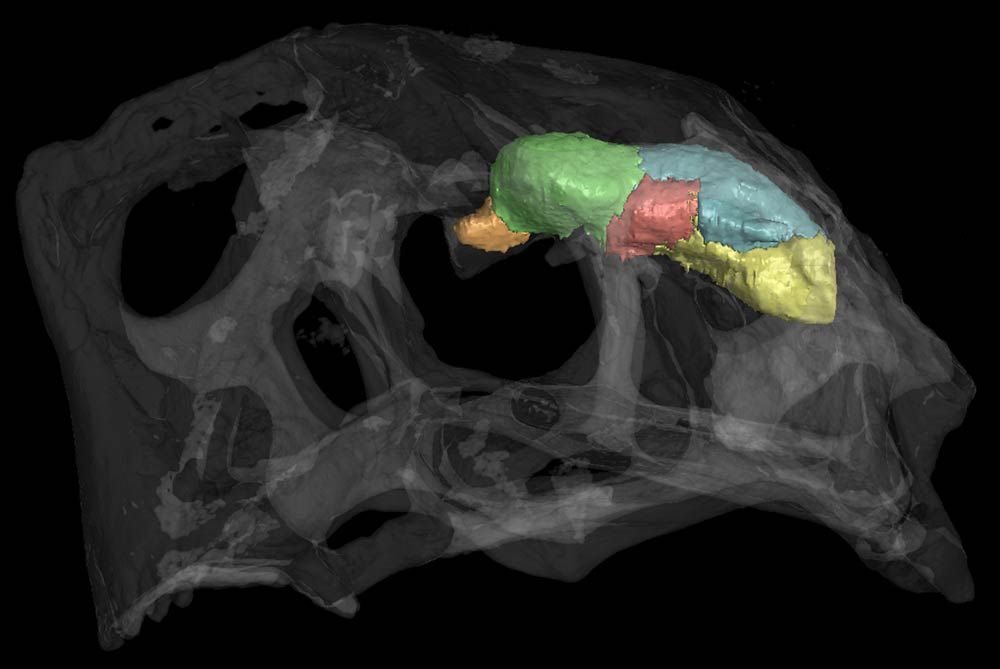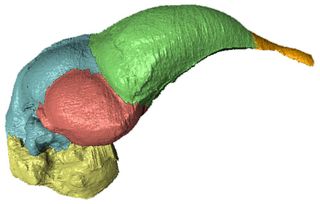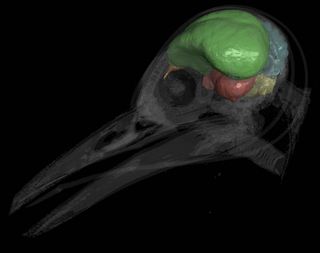Long Before Birds, Dinosaur Brains Wired for Flight

Some nonavian dinosaurs, including carnivorous tyrannosaurs, may have had brains that were hardwired for flight long before even the earliest known birds started flapping their wings, a new study finds.
Scientists used high-resolution CT scanners to closely study the craniums of modern birds, nonavian dinosaurs and Archaeopteryx, considered by some to be one of the earliest known birds. They found that characteristics of the typical "bird brain" could be found much earlier in history than was previously thought.
"What we think of as birdlike features — they keep falling down the evolutionary tree," said study lead author Amy Balanoff, a research associate at the American Museum of Natural History and a postdoctoral researcher at Stony Brook University, both in New York. [Images: Dinosaurs That Learned to Fly]
Archaeopteryxlived roughly 151 million to 149 million years ago, during the late stage of the Jurassic era. This early bird specimen has been branded as an evolutionary bridge between dinosaurs and modern birds, due to its signature blend of avian and reptilian features. The new findings, however, question whether Archaeopteryx, which was about the size of a raven, really was an evolutionary intermediate.
"Archaeopteryx has always been held up as a transitional species between nonavian dinosaurs and birds, but our study shows Archaeopteryx isn't unique in being in that space between more primitive dinosaurs and birds," Balanoff told LiveScience. "We found all these other closely related species that also fall in that close transitional space."

Head scans
Balanoff and her colleagues used CT scanners to measure the cranial cavities of more than two dozen specimens, including birdlike oviraptorosaurs and troodontids.
Sign up for the Live Science daily newsletter now
Get the world’s most fascinating discoveries delivered straight to your inbox.
"What's really interesting about birds is that as their brain develops, it fills so much of the cranial cavity that it creates an impression on the surrounding bones," Balanoff said. "If you fill that space in and get rid of the bones, you have a cast of what the brain looked like during life."
The researchers stitched together these scans to build 3D reconstructions of the skull interiors. This enabled the scientists to calculate the volume of the cranial cavities, and the size of each brain's major anatomical regions.
Modern birds characteristically have large cranial cavities relative to body size, Balanoff said. Structurally, birds also have large forebrains that equip them with the coordination and vision necessary for flying. The new research suggests some dinosaurs may have already evolved these brain capabilities, even if they never took flight. [7 Surprising Facts About Dinosaurs]
"For a long time, bird brains were considered really different than those in other so-called reptiles," study co-author Mark Norell, chair of the division of paleontology at the American Museum of Natural History, said in a statement. "This is another case where the attributes that we traditionally have associated with birds actually can be seen cascading down the tree of life. We can now say that the bird brain was present in animals that were not really birds."

The changing brain
The researchers also zeroed in on a neurological structure, called the wulst, which is present in living birds and is important for information processing and motor control. In their digital brain casts of Archaeopteryx, the scientists found an indentation that could be from the wulst, but this same structure was not observed in nonavian dinosaurs, the researchers said.
Still, by comparing the different brains, the scientists discovered that several other nonavian dinosaurs had larger brains relative to their body size than Archaeopteryx. Being able to peer inside the skulls of the different specimens enabled the researchers to trace evolutionary changes.
"The story of brain size is more than its relationship to body size," study co-author Gabriel Bever, an assistant professor of anatomy at the New York Institute of Technology, said in a statement. "If we also consider how the different regions of the brain changed relative to each other, we can gain insight into what factors drove brain evolution as well as what developmental mechanisms facilitated those changes."
The detailed findings of the study were published online today (July 31) in the journal Nature.
Follow Denise Chow on Twitter @denisechow. Follow LiveScience @livescience, Facebook & Google+. Original article on LiveScience.com.

Denise Chow was the assistant managing editor at Live Science before moving to NBC News as a science reporter, where she focuses on general science and climate change. Before joining the Live Science team in 2013, she spent two years as a staff writer for Space.com, writing about rocket launches and covering NASA's final three space shuttle missions. A Canadian transplant, Denise has a bachelor's degree from the University of Toronto, and a master's degree in journalism from New York University.